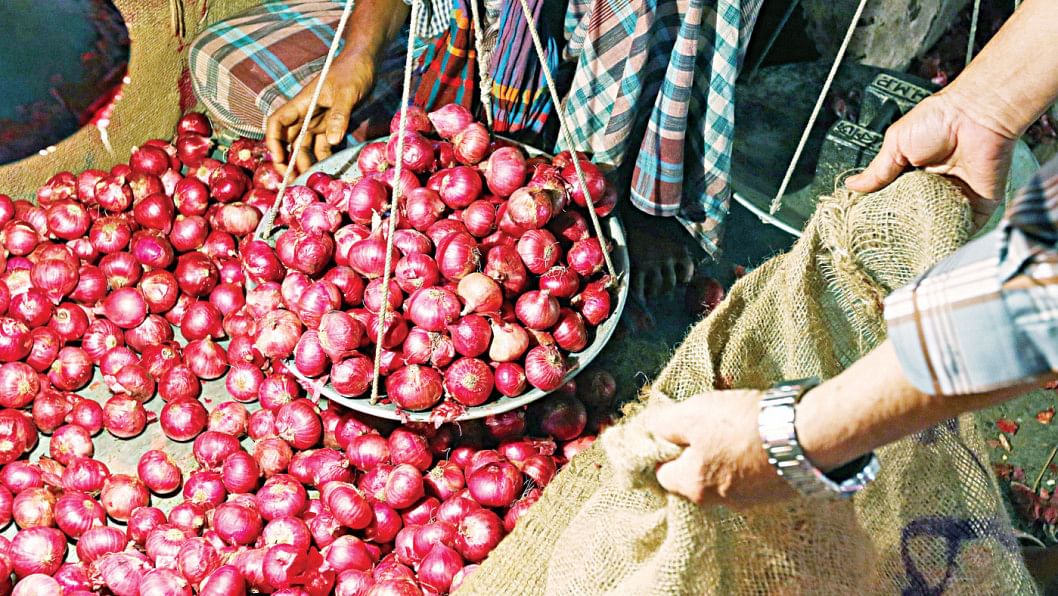Onion: a pungent cry

Indian onions would only be included in salads at five-star hotel dining here if Bangladesh could meet demand for the commodity with local produce. The country would not have to sacrifice the timeless tastes of Bangladeshi cuisine because of cooking with the less-in-flavour Indian onions.
This is what Narayan Chandra Saha, an onion importer at Shyambazar in Old Dhaka, feels.
He was speaking to The Daily Star on the recent hike in onion prices and its current market scenario. The businessman pointed at the recent floods in Indian states for the hike.
"The floods once again showed us how dependent we are on Indian onions." Local onions are better than Indian ones, and are more expensive as well. Import makes the balance, Saha said.
"If there were no floods, the import of onions would not have been hampered and there would not be any price spiral."
Nearly 80 to 100 trucks laden with Indian onions entered Bangladesh every day since the end of March through the Benapole, Bhomra, Hili and Sonamasjid land ports, he said.
On the other hand, nearly 200 tonnes of local onions come to Dhaka from different districts in Bangladesh. Local and Indian onions are usually priced at Tk 18-20 a kilogram and Tk 20-22 a kilogram this season, Saha said.

"But prices of local onions went up to Tk 70 a kg in the absence of its Indian options, thanks to an export ban by the Indian agriculture ministry from December 20, 2010, after the floods."
"The ban influenced Bangladeshi growers to harvest bulb onions even before maturity, in hopes of making some early profit, pulling the onions production down to 8 maunds from 12 maunds."
Bangladesh is not rich in onions. The product is farmed in a few districts, like Faridpur, Rajbari, Ishwardi, Shariyatpur, Kushtia, Pabna, Madaripur, Meherpur, Chuadanga and Manikganj. Because of the ban, local onions are now sold in the market.
"We have already finished selling the onions that came from Ishwardi. We sold three fourths of the onions from Pabna. Now, onions from Faridpur are ruling the market."
"But the best onions will come from Meherpur this season after 15 to 20 days," Saha said.
"The bulb onions were never treated as regular onions as those taste much lighter than other varieties and cannot be stored for more than 10 days."
The storage variety of onions will appear in March and can be found in markets till December. These onions have a storage life of 8 to 10 months. The storage onions provide 4-times better produce than bulb onions, he said.
"People are selling storage onions at around Tk 1,500 a maund, almost two times more than the purchasing price of Tk 650-700 a maund last year."
Bangladesh can hardly meet its five-month demand for onions with local produce. Moreover, business-people release the onions in stages, depending on market prices.
This season, storage onions may be priced at Tk 800-900 a maund, while a large portion will be stored, he said. The storage onions are rain-sensitive.
"There will be a huge loss if it rains in February, as growers will not get a second chance to farm the variety again this season."
Bulb onions are usually found till mid March, while storage onion production starts at the end of March.
"If there are no natural calamities in the next 2 to 3 months, onion production will be huge this time."
But Bangladesh should work for self-sufficiency in onions, Saha recommended. The government could restrict Indian onions from entering Bangladesh for at least two to three months, when local variety hits the markets, he said.
"This will ensure good prices for farmers and inspire them to allocate more lands to produce the vegetable next year."
"Our agriculture ministry should actively work to find out why all the 64 districts in Bangladesh can't produce onions. But the government should think about the consequences of what would happen if the Indian floods did not occur in the peak season of our local onions."

 For all latest news, follow The Daily Star's Google News channel.
For all latest news, follow The Daily Star's Google News channel. 



Comments